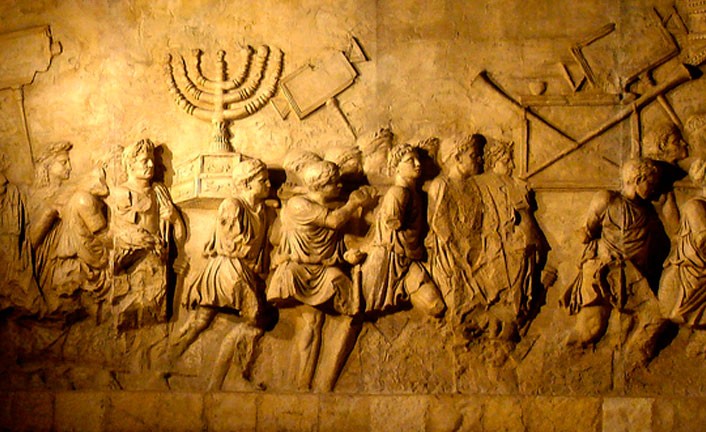The Jewish Revolt
In the first century, the different ways to interpret the Law of God, their sources and forms of living the Jewish religion contributed to the Jews division into several groups, also called Jewish sects. The main ones were the Pharisees, Zealots, Sadducees, Herodians, Essenes and Sicarii.
Pharisees: They were the most admired by the people at the time of Jesus. They were dedicated to the matters of fulfilling laws and purity rituals, even outside the Temple. They compiled a number of traditions that were verbally passed down through the generations, in order to comply with the law, thus creating the oral Torah, considered by them with the same force and importance as the Torah given to Moses.
Zealots: They were a branch of the Pharisees that believed being religious was not enough, but that politics were decisive and vital, since no foreign power could be greater than the sovereignty of God. They also thought Salvation was granted by God and were convinced the Lord required a partnership with man to achieve this Salvation.
Initially, this partnership would only be religious to fulfill the Law, but, over the years, with imposition from the Roman Empire, they believed this alliance must also be military, being a martyrdom to fight and die to sanctify the Name of God. They were the most radical and believed that the Messiah was linked to a revolutionary act against Rome and the Hellenistic influence. They were known for being ardent.
Sadducees: They were people of power, from high society, members of priestly families, educated, rich and aristocrats. Most of the members of the Sanhedrin (council that judged matters of Jewish law and criminal justice in Judea and in other provinces) were Sadducees. They looked to abide by the decisions of Rome, giving more importance to politics than religion.
They were not well liked by the people, since they were part of the elite and accommodating to the Romans. Since the beginning of Roman occupation, the high priests were chosen from among them. They were the Jewish representatives before the imperial power. They made a very sober interpretation of the Torah, and did not believe in the oral Torah. Unlike the Pharisees, the Sadducees did not believe in life after death, nor shared hopes.
Essenes: This sect was composed of people who left Jerusalem and other places to live isolated in the desert, with a life of simplicity, in order not to be contaminated by other sects. Many Essenes had been Pharisees and even Sadducees, but renounced everything they had. Their existence was proven in the Dead Sea scrolls, found in Qumran, here in Israel.
A specific characteristic of the Essenes consisted of not accepting the cults practiced in the Temple of Jerusalem, because it was performed by a priest with connections to Rome, not chosen by God. As a result, the Essenes chose to separate themselves from these common practices with the intention to preserve and restore the sanctity of the people in a more limited scope: their own community. They did not believe in free will; everything was determined in advance by God. They spent part of the day rewriting the Torah. They took two ritual baths a day.
Herodians: Stemming from the left-wing of the Sadducees, they believed, for their own convenience, that Herod was the Messiah. They were great supporters of Herod, always interested in obtaining or maintaining some kind of benefit. They were like the Sadducees, much more connected to politics than religion. Among the Jews, they were sworn enemies of the Zealots.
Sicarii: They were a radical extremist group that most likely branched out from the Zealots. They committed horrible acts against Romans and the Jews that supported them, mixing in among the crowds during public gatherings in order to escape.
The Sicarii were one of the first organized groups whose objective was to carry out attacks. Their goal was to expel Rome from Israel, especially from Jerusalem, returning power to someone chosen by their own priest, and not the elite. Sicarii means dagger men, because they would wear one hidden in their clothes. They caused the Great Jewish Revolt, which lasted from 66 to 70 A.D.
As we can see above, the Jewish people existed, but were disunited, divided, with diverse ideals, supported by contradictions, living by politics or religion, following selfish leaders and living in total submission, whether by interest or by fear.
Reasons that led to the revolt of the Jews:
Rome had been in power for several decades, treating Israel like one more of their provinces and with Jewish aristocracy and political leaders (Sadducees) on their side. Roman power was so great that they significantly increased Jewish taxes. Taxes were so high that Romans created a tax collection franchise system and those who had this franchise were called publicans.
Some publicans had their own collectors, as was the case of Zacchaeus, who was the head of the publicans in Jericho. The publicans were charging more taxes than the Roman Empire required and they would keep the difference. They offered sacrifices to the Roman emperor in the Temple of Jerusalem, desecrating the holy place of the Jews.
In other places, Greeks sacrificed pigeons in front of synagogues and Romans did not oppose in favor of the Jews. Romans stole seventeen talents from the Temple treasury to give to the emperor. When the Jews revolted, the Romans arrested and crucified more than five hundred people, even though many of these Jews were Roman citizens.
Afraid, the Jewish people wanted to make a peace agreement with the Romans, subjecting themselves once again to their demands. Seeing this, the Sicarii joined the Zealots and destroyed all the food reserves in Jerusalem, leaving the people in utter despair. They did this to motivate the people to revolt against the Romans instead of making a peace agreement.
The Zealots, the Sicarii and other prominent revolutionaries finally joined forces to attack, and so managed to free Jerusalem in 66 A.D., retaking control of the Temple and executing anyone that tried to stop them.
At the time, Vespasian was the Roman general assigned to end the rebellion in the province of Judaea. His son, Titus, was also renown. They succeeded in Galilee, but faced major military losses in the center and in Jerusalem. One of the most significant battles was in Beth Horon, where Jews came together to face and defeat several Roman legions, totaling 30,000 armed and well-prepared soldiers, and killing 6,000 of them. The rest fled to Syria.
The Romans thought Vespasian would displace other Roman legions in the war against the Jews. However, he crossed his arms and said it would be wiser to wait, because the Jews were a strong force when united, but history confirmed that they could not remain in peace with each other for very long. All the Romans had to do was wait because they would fight and kill each other, weakening their strength. No sooner said than done.
Vespasian was called back to Rome in 69 and became the Emperor. Titus, his son, was in charge of planning the siege of Jerusalem. In 70 A.D., a civil war among the Jews broke out in Jerusalem, each with divergent ideals, fighting and killing each other. Titus took advantage of the weakening of the Jews to gradually siege and invade the city. There were three protective walls in Jerusalem. The first two were destroyed in a few weeks, but the third took seven months to destroy. The Roman invasion led to the destruction of the Temple in Jerusalem.
In the image above, the Arch of Titus in Rome commemorates the conquest of Jerusalem, the destruction of the Temple and the plundered treasures that were taken back to Rome. This image allows us to calculate the approximate size of the Temple Menorahs.

 Portuguese
Portuguese
 Spanish
Spanish
 French
French
 Italian
Italian
 Haiti
Haiti
 Russian
Russian


